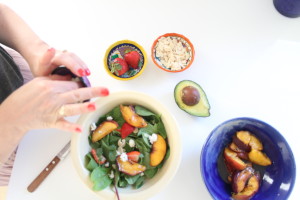Part Two Of Our Three Part Mini-Series Keeping Up With Your Your Kitchen

In the first part of this mini series, we talked about ridding our pantries of foods that had a lot of preservatives and those easily exposed to BPA. Be sure to check out our first post Revamp Your Pantry. This week we continue our Keeping Up With Your Kitchen series with how to Refresh Your Fridge.
To help keep us eating healthy all week long it’s so important to keep an organized fridge. A cluttered refrigerator can get overwhelming, especially if we are looking for healthy options to grab when we are rushing around in the morning before work.
Just like our food pantry we tend to buy food and just toss it in the fridge before getting rid of older foods. Refrigeration is crucial for the longevity of our fresh produce. The cold temperature prevents the spoilage of food and the spreading of bacteria that can cause food borne illness. Placing different items in the fridge is important to making sure all of the food stays safe to eat because the temperature of the fridge varies depending on where the cooling element is located.
Here’s a quick breakdown On How To Organize Your Fridge
Upper shelves: Leftovers, drinks, ready-to-eat foods, herbs.
- It’s best to keep these on the top shelves so we can always be aware of what we have on hand. Also, these items tend to be bigger in size and this will help to make space for other foods.
Lower shelves: Eggs, dairy, raw meats
- Food borne illness is always something to consider when packing the fridge. These items are high risk for spreading food borne illness and placing them on the bottom shelves will keep them away from fruits and vegetables.
Doors: Condiments, juices, water
- To put it simply, these items fit particularly well in the spaces of the refrigerator door. It seems as if they are meant to be here! Some essentials to always have on hand are pickles, mustard, kimchee, ginger, garlic and organic ketchup. All of these condiments are great for adding in different tastes and textures for meals. Just be careful and read the labels, a lot of condiments tend to high fructose corn syrup in them and it’s best to avoid.
Crisper: Fruits and vegetables (should be kept separately)
- The temperature within the crisper is ideal for fruits and vegetables. Keeping fresh produce in the crisper will increase its’ shelf life and make it delicious to eat. Make sure to keep the fruits a vegetables separate. It is very common for them to spoil quickly when placed together.
Fruits and veggies that can go in fridge:
- berries, cherries, bell peppers, cucumbers, celery, carrots, leafy greens and citrus fruits.
Certain vegetables such as tomatoes, squash, onions or potatoes do not need to be stored in the refrigerator.
- They do not require the colder temperature of the fridge to stay fresh. These vegetables should be kept in a neutral environment with low moisture or be left in a dark cupboard outside the fridge.
Fruits and veggies to be stored outside fridge: pears, non-cherry stone fruit, avocado, melons and mangos.
Organizing the refrigerator may seem tedious, but after doing so myself I find it so much easier to go about making healthy eating habits.
With daily life always being extremely busy, keeping my area organized is the only way I can keep up with a healthy lifestyle. Now that our kitchen is organized, it is time to start meal prepping!
Come on over to our meal prepping post and learn how to prepare for the week and get your gift from us a meal prepping plan with some of our favorite recipes.

.png)
.png)
.png)